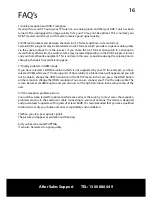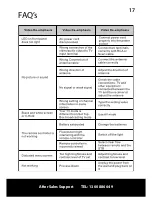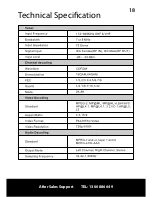
After Sales Support TEL: 1300 886 649
16
FAQ’s
1) Analog reception and DVB-T reception.
If you wish to watch TV using your TV tuner (i.e. an analog tuner) and that your DVB-T unit has been
turned off or unplugged, the image quality from your TV may not be optimal. This is normal; your
DVB-T receiver must be set to ON mode to receive good signal quality.
2) Different volume levels between channels in AC3 format and those in stereo format.
Certain DVB-T programs may be broadcasted in AC3 format, which provides a superior audio quality
via the coaxial output from the receiver. If you chose the AC3 format and switch to a channel in
stereo format afterwards, the audio volume may increase depending on the DVB-T program format
and your home theatre equipment. This is normal; in this case, consider reducing the volume prior to
changing channels to avoid listening gene.
3) Display problem in HDMI mode.
If you have selected a HDMI resolution which is not supported by your TV (for example, you have
selected 1080i while your TV only supports 720p resolution), a black screen will appear and you will
not be able to change the HDMI resolution in the SETUP menu.In this case, press the HDMI button
on the remote to change the HDMI resolution. You can also connect your TV with a video cable. The
screen becomes readable again, and you can now set the right resolution in the setup menu of the
unit.
4) If the reception problem persists:
Your unit has been tested for optimal performance all over the country. In most cases, the reception
problems are due to the antenna or cable connecting to your roof antenna. This device is designed
and guaranteed to operate with signals of at least 60dB. It is recommended that you ask a qualified
technician to verify your home antenna’s compatibility and installation.
5) When you view poor quality signals:
The picture will appear as pixilation and freezing.
6) If you hear the sound POPPING:
It can also be related to signal quality.


















